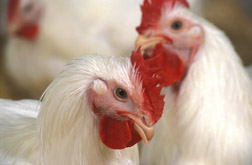Seven Decades of Fighting Chicken Diseases
|
|
The ARS Avian Disease and Oncology Laboratory (ADOL) at East Lansing, Michigan, has fought since the 1930s to stay at least one step ahead of emerging chicken diseases. Next to Michigan State University, the lab was formed during an epidemic of avian leukosis complex. The disease was later found to be caused by several viruses, including avian leukosis virus (ALV) and Marek’s disease virus.
Like all viruses, these mutate frequently, ever evolving into more powerful forms. In 1989, ALV evolved into the most virulent subgroup yet, called “subgroup J.” The ALV-J version spread much faster than all earlier ones, and new techniques were required in the detect-and-eradicate approach to dealing with them. These viruses caused a worldwide epidemic in 1996 that continues to require constant surveillance to this day.
ARS was instrumental in developing a quick lab test for ALV-J, which was rapidly adopted by commercial poultry breeders worldwide.
Marek’s disease, too, has been held in check through continuing ARS efforts. Veterinary medical officer Richard L. Witter, retired but still collaborating at East Lansing, developed the first vaccine against Marek’s as well as several updates of the vaccine as the disease evolved. There is no treatment for Marek’s disease, which is often fatal in birds younger than 16 weeks. The lab is working on the next generation of vaccine.
To escape the endless cycle of increasing viral virulence and frequent vaccine updates, ADOL scientists are trying to breed disease-resistant “superchickens.” They are relying on the chicken genome map and new genetic tools for more precise guidance in their breeding efforts. ADOL researchers worked with an international team that developed the genome map—the first for a barnyard animal.
The lab is also the guardian of a unique chicken gene pool, maintained since the 1930s in live chickens that are carefully quarantined and protected. They preserve over 50 inbred lines of chickens, some of which are specially bred to make it easier to spot genes that might be related to disease resistance.
Cells and fertile eggs from these chickens are sent to university and industry researchers worldwide to help them develop vaccines and other control measures.
There are only eight major chicken breeder companies worldwide. Since the low per-bird value of chickens makes it less economically feasible to do the amount of research that is done for animals like beef cattle, the industry depends heavily on the East Lansing lab.
“New strains of old diseases that overpower our defenses will continually emerge, because viruses constantly mutate and evolve,” says Aly M. Fadly, the ARS veterinary medical officer who heads the lab. That fact will keep the ADOL team constantly on alert.—By Don Comis, Agricultural Research Service Information Staff.
This research is part of Food Animal Production (#101) and Animal Health (#103), two ARS National Programs described on the Web at www.nps.ars.usda.gov.
Aly M. Fadly is with the USDA-ARS Avian Disease and Oncology Laboratory, 3606 E. Mount Hope Rd., East Lansing, MI 48823-5338; phone (517) 337-6829, fax (517) 337-6776.
"Seven Decades of Fighting Chicken Diseases" was published in the June 2006 issue of Agricultural Research magazine.







